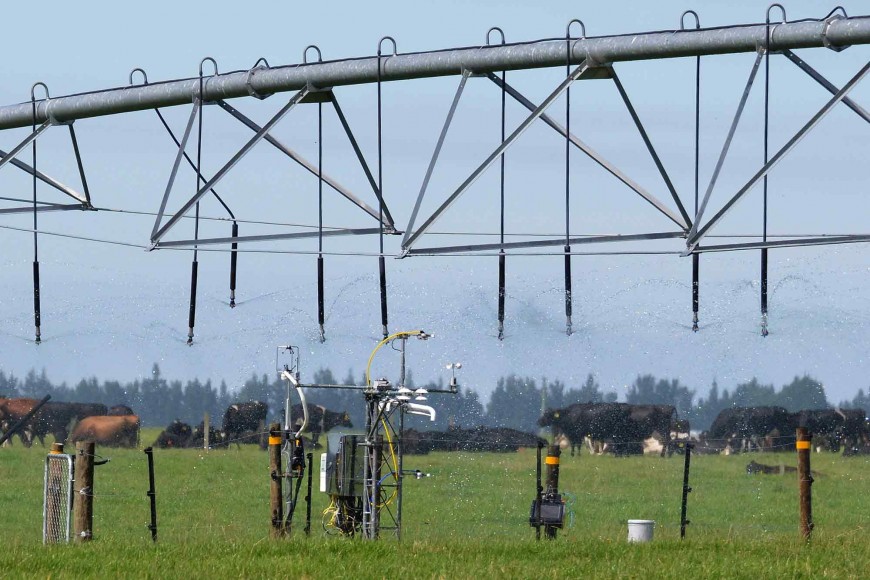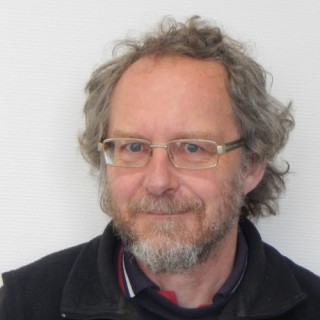This science is becoming more and more sophisticated. As gas gets exchanged at plant or soil surfaces, it is transported vertically by turbulent eddies. Instruments placed on towers above the surface can measure these eddies, which then allows the fluxes of carbon dioxide, water vapour and other gases to be calculated.
Improvements in technology and data processing power have allowed these flows to be measured and modelled in ever-increasing detail and has led to the development of a global network of about 1000 flux towers known as FluxNet.

Example of a flux tower on a dairy farm in mid-Canterbury. Photo: John Hunt.
Fluxes of nitrous oxide and methane can also be measured, which is important to help New Zealand’s agricultural sector to assess the effect of different management options on total greenhouse gas emissions.
OzFlux, which counts Manaaki Whenua as a partner organisation, is part of FluxNet. The OzFlux network was set up in 2001 to provide Australian, New Zealand and global researchers with consistent flux data for Australia’s and New Zealand’s unique ecosystems. Since then, it has matured into a network that provides relevant and robust data and information on ecosystems for researchers, resource managers and policy makers, with an important emphasis on data sharing and integration.
Ecosystems measured by OzFlux span a huge range of bioclimatic conditions, from alpine to tropical, from coastal to continental, and from deserts to rainforests. This wealth of data is also being used to develop sophisticated ecosystem models that are being tested and verified with the OzFlux data. These models allow researchers to make powerful predictions about the future and the responses of ecosystems to our changing world: for example, will ecosystems switch from being carbon dioxide sinks to carbon dioxide sources? Will agricultural productivity increase or decrease? Are some systems particularly vulnerable? Will the emissions of other greenhouse gases increase or decrease?
And most importantly, what can we do minimise any harm, while making the most of any new opportunities?
A recent study by OzFlux scientists, including Dr Miko Kirschbaum and Dr Johannes Laubach of Manaaki Whenua, has outlined the important contributions made by the OzFlux network over the past 20 years to global understanding of how climate affects carbon fluxes.
OzFlux has allowed researchers to:
- develop the science and models needed for accurate ecological forecasts and longer-term projections of responses to climate extremes.
- document ecosystem recovery from disturbances such as storms and fire.
- study the fluxes associated with agricultural ecosystems to understand what combinations of farming practices and environmental factors lead to carbon gains and losses.
- diagnose year-by-year variability in the carbon cycle and net greenhouse gas emissions.
- verify carbon market products and greenhouse-gas mitigation approaches.
- benchmark and improve models of terrestrial ecosystems and understand their important feedbacks to climate change.
- evaluate and improve simulations of the feedbacks between the land and the atmosphere during short-term events such as heatwaves and droughts.
This underpinning science is vital to enable climate-smart future land management. It demands continuity of data collection over many decades.
Some OzFlux sites, particularly in New Zealand, have been dedicated to investigating the net carbon gains or losses (including carbon dioxide as well as imports and exports) of pastoral agriculture and from conversion of pasture to forest. Two teams participating in OzFlux, at Manaaki Whenua in Lincoln (including Johannes) and at the University of Waikato, operate sites to determine net greenhouse gas balances of grazing systems and to test mitigation approaches. Manaaki Whenua scientists in Palmerston North (including Miko) use these data to model the underlying processes.
Manaaki Whenua’s scientists will continue to contribute to the important global resource provided by OzFlux. Future development of the network will include further integration of the tower stations with remote sensing technologies; more research about how soil processes contribute to the fluxes, including how soil moisture affects plant transpiration; and exploration of how changes in land use or management impact net greenhouse gas emissions.
Key contacts

Miko Kirschbaum

